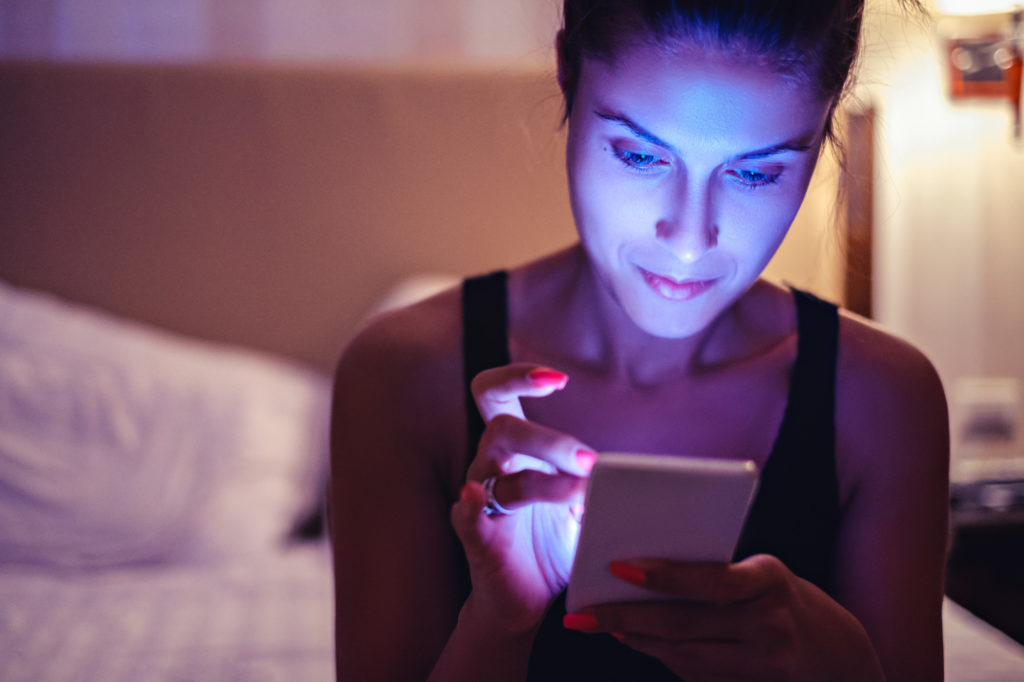Blue Light Effects: What Your Smart Devices Are Doing to Your Brain and Body
Category: Healthy Living
Author Vanessa
Posted on October 8, 2020
Vanessa is a health writer and blogging expert. Her specialities are medicine, health and wellness. She is proud to call Vancouver, BC her home where she enjoys the ocean and mountains with her dog Mr. ChowChow.

You love them, but your smart devices are likely harming your health! It can be hard to imagine that the tiny light coming from your phone or computer, can be causing you harm. It’s just light after all, right? Nope.
Over the decades since the invention of electricity, we have been lengthening our exposure to light. Now, we are extending it to lengths that are doing damage to our brains and our bodies. The blue light from your smart devices can significantly affect the health of your brain and body. As average smart device usage increases, so does the harmful blue light effects of your screen time. With a few adjustments, you can curb your blue light exposure and improve your health.
What Is Blue Light and the Blue Light Effect
Blue light is a short wavelength light (versus red light, which has a longer wavelength). Because it is a short wavelength light it can affect your brain and body. The blue light effect is not all negative, you need it, but too much of it can be harmful.
Light waves emit energy that ranges in its strength and length. The shorter wavelengths have more energy than the longer wavelengths. The short wavelength of blue light affects your body and brain in several different ways.
Natural blue light from the sun is helpful. It can help keep you alert, mentally focused, boost your mood, and give you a sense of well being. But, blue light coming from your smart devices can be harmful. Blue light can overstimulate your nervous system. It can also cause mood disorders, sleep disruptions, eye strain, headaches, and fatigue.
The use of smart devices is dramatically increasing every year. As is the blue light effect on your brain and your body. You can increase your physical and mental health by understanding harmful blue light. Learn where it comes from and how to reduce its effects.
The Sources of Blue Light
Blue light is found all around us. It naturally comes from the sun and artificially from fluorescent bulbs, LED lights, TVs, ebook readers, and smart devices. It has consumed almost every waking and, now sleeping, moment of our lives.
You can cause a cascade of health issues by reading on your blue light emitting devices in the evening. The negative health effects start with trouble falling asleep. They also contribute to poor quality of sleep and less REM (rapid eye movement) sleep.
Why Our Circadian Rhythms Are so Important
When you don’t get enough sleep, you are adding stress to your body. Stress on the body can cause disease, illness, and mood disorders. Sleep quality will either help improve or increase your daily stress. Adequate and quality sleep is essential to your well being. Blue-light emitting devices threaten your sleep.
Sleep is critical to your health, making sure you have practices in place to sleep enough and to sleep well. Sleep is dependent on your 'circadian rhythm'.
Your circadian rhythm is a natural body process that regulates your daily sleep-wake cycle. Disruption of your circadian rhythm can lead to issues such as slower thinking, weight gain, mood swings, depression, and obesity.
The primary hormone blue light affects in our circadian rhythm is melatonin. If you are lacking melatonin it can lead to insomnia and poor sleep. Melatonin is produced in the body and helps you sleep.
The more darkness you are exposed to, the more melatonin you produce. The more light exposure you get (including blue light exposure), the less melatonin you will produce. Low melatonin levels will signal your body to stay awake. You can ease the negative effects of blue light by limiting exposure to your devices. This can increase your ability to have a better quality of sleep.
Beneficial Effects of Light
Bring on the light and bright! As humans, we tend to want lots of light in our homes and offices. Light helps to boost our productivity, our mood, and as an aesthetic of our environment.
There are many benefits you get from light and we need to have sunlight exposure. Sunlight aids in producing vitamin D, which is a required nutrient for health. It aids in strong bones, mental clarity, energy, and muscle function.
Natural light and darkness help us to thrive. The natural light cycles help maintain our natural circadian rhythms.
Harmful Effects of Light
Too much of a good thing is a bad thing. When the homeostasis of your body’s systems is disrupted, it sends your health into a downward spiral. The negative effects are more than a poor night’s sleep, they are accumulative and can be devastating.
Sleep and Stress
Not enough sleep upsets your circadian rhythm and causes physical stress on your body. This stress is a chemical response, intended to protect you from a physical threat. Sleeplessness and daily stress are not a physical threat. A mountain lion attacking is a physical threat. This stress response builds up over time and tells your brain to make this a default setting.
Having a stress response as a default-setting creates yet another negative cascade effect.
Digital Eye Strain
Eye strain traditionally comes with age. But, now we are seeing it with kids as well as adults. Digital eye strain is coming from prolonged electronic screen use.
Circadian Rhythm Disruption
Circadian rhythms are essential for regulating your nervous system. It also aids in the rest and restoration of the body and the brain. Increased blue light exposure has a direct negative effect on your circadian rhythm. Lack of sleep can lead to diabetes, heart disease, and obesity.
Depression
The blue light effect on your brain can be significant. Overexposure to blue light can trigger the release of your stress hormones. Your primal brain thinks you need to be awake and alert for a potential physical threat. This triggers a stress response in the body and releases stress hormones.
This chemical response, when chronic will cause systemic inflammation in the body. These stress hormones also affect the brain and can lead to mood disorders, such as depression, anxiety, or mental fog.
Your stress response limits your access to brain function. This limitation makes it more difficult to work through depression and anxiety. You can reverse these effects by reducing blue-light exposure from screens. Creating habits to calm your nervous system will further help reverse these effects.
Macular Degeneration
Macular degeneration is an eye disease in which part of your eye is damaged. You can have permanent vision loss. Studies have shown that chronic exposure to blue light can increase your chances of macular degeneration and other eye diseases.
Tips to Limit Blue Light Exposure
You are not likely to give up your smart devices, and that is not even realistic in your life. However, you can take action to limit the amount of blue light effect on your brain and body. The following are some steps you can take now to reduce the blue light effect and get better sleep.
Limit Screen Time
Limiting your screen time is probably the most difficult, but when done in small steps can be achievable. Set times for when you’ll log off and shut down screens, such as two to three hours before your bedtime. This will also have a side benefit of helping you get to bed on time to get enough sleep for your day. You also can set up new activities to enhance your circadian rhythms. Meditation is also a useful tool for sleep and stress relief.
Use Dim Red Lights for Evening lighting
Unlike white (day) or blue (screens) lights, red light (or even yellow or orange) does not affect our circadian rhythms. Use a red light in the evenings for ambient lighting around the home.
Blue-Blocking Glasses
Blue-blocking glasses are glasses that block blue light. This can either be a coating or as tinted glasses. You can wear them in the evenings and anywhere there is artificial lighting. The glasses are especially helpful for night-shift workers, or if you’re working late on your computer or another type of screen or smart device.
Night Shift Settings
Most screens on your smart devices now come with a setting called ‘Night Shift’, which creates a yellow light, helping to reduce the blue light effect. The night shift setting can be set to specific times or often it allows you to select a sunset/sunrise setting and automatically adjust the screen’s color output.
You can also adjust the screen brightness, dim it in the evenings to reduce the amount of blue light coming at you.
Natural Sunshine
Get real sunshine exposure during the day. Daylight will help your circadian rhythms in a natural balance, which will help you to sleep at night. Daylight exposure also has a side benefit of helping boost the mood. Be conscientious about when you are taking in light (natural or artificial) and help your brain and your body to maintain its natural healthy state.
Reset Your Circadian Rhythm
You can be proactive in your health by creating habits to support your natural circadian rhythm.
Make sure to consume nutrient-dense foods and stay well hydrated to support your stress response. Lack of nutrients can signal the brain that you are in a state of survival, and will trigger a chemical stress response in your body.
Actively work to reduce stress with exercise during the day and calming stretching before bed. Keep sleep schedules. It is common to skip on a full night’s sleep with the idea of “catching up” on the weekend. However, regular sleep is supportive of your natural rhythms. Meditate before bed to calm your brain’s stress response and prepare your mind for restful sleep.
Other Tips
- Reduce or dim ambient lighting so there is less blue light coming at your eyes.
- Keep your screen clean and free of dust to reduce screen glare.
- Take frequent breaks, such as a break every 20 minutes, and look at anything other than your screen. This will give your eyes a break and help strengthen your sight by focusing on objects at varying distances.
- Blink more often. Blinking gives your eyes a fresh coat of tears, which also cleans and moistens your eye, helping to sharpen your vision and reduce strain.
- Change your lightbulbs to a warmer tone (yellow or ‘soft’ light bulbs) to help reduce the amount of blue light disrupting your circadian rhythms.
Setting Boundaries on Your Screens for Your Health
Our brains and bodies are fine-tuned machines. We can adapt and change; however, we are still biological creatures with basic biological needs. Our daily screen habits can have a significant impact on the health of our brains and bodies. Monitoring and reducing average screen times can help give us the needed break from blue light effects and improve our health.
The harmful artificial blue light coming from our smart devices is increasing with your use. It disrupts natural circadian rhythms, can cause mood disorders, reduce brain function, cause inflammation leading to disease and illness. Limiting your exposure, especially in the evenings, can significantly help reduce these dangers and help restore stronger physical and mental health.
Learn more about health and wellness on our blog.
Works Cited
- Sleep and obesity: https://www.health.harvard.edu/blog/weekend-catch-up-sleep-wont-fix-the-effects-of-sleep-deprivation-on-your-waistline-2019092417861
- Insomnia https://www.pricepropharmacy.com/categories/insomnia/
- Vitamin D: https://ods.od.nih.gov/factsheets/VitaminD-HealthProfessional/
- Smart device usage: https://www.marketingcharts.com/digital/non-mobile-connected-devices-111854
- How the timing of light affects us: https://www.ncbi.nlm.nih.gov/pmc/articles/PMC5299389/
- Harvard eye study. https://www.health.harvard.edu/blog/will-blue-light-from-electronic-devices-increase-my-risk-of-macular-degeneration-and-blindness-2019040816365
- Diabetes: https://www.pricepropharmacy.com/categories/diabetes
- Depression: https://www.pricepropharmacy.com/categories/depression/
- Meditation: https://www.pricepropharmacy.com/what-are-the-benefits-of-meditation/
- CDC.gov https://www.cdc.gov/niosh/emres/longhourstraining/color.html#:~:text=Exposure%20to%20white%20light%20during,or%20orange%20light%20at%20night
- Harvard Health: https://www.health.harvard.edu/blog/weekend-catch-up-sleep-wont-fix-the-effects-of-sleep-deprivation-on-your-waistline-2019092417861
- Night shift setting work: https://blutechlenses.com/blog/does-apples-night-shift-feature-block-blue-light/#:~:text=Apple's%20latest%20feature%2C%20Night%20Shift,blue%20light%20your%20device%20emits.&text=While%20it's%20a%20significant%20step,efficiently%20block%20all%20blue%20light.
- Blue Light Exposed: http://www.bluelightexposed.com/#what-is-bue-light



